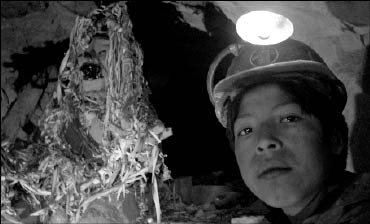The Devil and His Due: The Devil's Miner
by George Sax

The twisting, deeply subterranean tunnels of the silver mines of Cerro Rico don’t seem an inappropriate setting for the devil cult practiced by the miners, and not just because the mines are underground. The hellish working conditions in these mines in the mountains of south-central Bolivia make those in the laxly regulated West Virginia mine where more than a score of men perished after an explosion last fall seem salubrious.
About 9,000 Quechuan men, descended from the Incas, toil in the mountain’s bowels, using antiquated equipment, their way lit by carbon-flame lamps that also serve as primitive poison gas detectors, as temperatures rise as high as 105° F.
Among them are perhaps 800 children. Kief Davidson and Richard Ladkani’s quietly sympathetic and surprisingly attractive documentary, The Devil’s Miner, focuses on one of them, a bright, appealing 14-year-old named Basilio Vargas. Basilio is the primary generator of his family’s meager income. (His mother is employed by the mine as a caretaker, and his 12-year-old brother, Bernadino, works with him down below.)
The boys, and their younger sister Vanessa, once had a father who worked as a textile trader in Portosi, the city below Cerro Rico where they all lived. But after his death years ago, they were reduced to their very straitened existence, dependent on the mine operations for survival. The little money they obtain this way is necessary for more than subsistence: The two boys attend school for a half-day in Portosi, and Basilio and his mother’s hope for escape from their chronic plight is precariously based on educational advancement.
Basilio, who provides the largest part of the film’s shared narration, notes that they save money for school fees and uniforms, even if it means denying themselves food (except for Vanessa).
The Devil’s Miner has to have been one of the more difficult shoots in recent documentary history. Davidson and Ladkani (who was the pair’s cinematographer) follow the boys and men into the mine’s cramped maze of shafts, through hot, hazy, dirty air, to record their difficult activities and comments. (Some of this footage is technically and otherwise very impressive.) At one point, they hurry up from the shaft behind Basilio after he has detected the sound of an explosion of which he wasn’t warned, and thus fears another, closer one.
The propiation of Satan, which occasionally involves ritual animal sacrifice and the spattering of blood, is an ethnically atavistic practice that is at once peculiar and symbolic of the miners’ restricted, hazardous existence. Like some of the older miners, Basilio can calmly recount the origins of these rituals in the most brutal exploitation of the Indians by the Spanish Empire in the 16th century. Yet, he seems to accept the wisdom of trying to elicit the protection of the lord of the lower depths. God doesn’t seem to follow the miners into these recesses. As a young priest in Portosi observes ruefully, “They live in fear…Nobody can grasp what they go through.”
Amid their lives of scant hope and comfort, the people in the movie have a humane dignity and an informed insight into their condition. Basilio expresses a barely hopeful, sometimes sadly wise understanding. He’s a resourceful, gritty, but nonaggressive kid. “The mountain eats men,” he tells us. And his mind can contemplate dimly revealed possibilities of other, better lives, in the city and region, across Latin America and even beyond.
The film’s approach, while both intimate and visually sweeping, doesn’t impart some basic information. Who owns the mines? How corrupt are the regional and national governments? Is there any regional political movement working to alleviate the Indians’ burdens? It’s a little hard to tell if they’re among the myriad victims of globalization, or if its too frequently dubious modernizing benefits haven’t reached Portosi.
The Devil’s Miner leaves Basilio and his family awaiting better days that may require more than this charming, intelligent boy’s efforts.
|
Issue Navigation> Issue Index > v5n16: This Is Buffalo Hip-Hop (4/20/06) > The Devil and His Due: The Devil's Miner This Week's Issue • Artvoice Daily • Artvoice TV • Events Calendar • Classifieds |









 Current Issue
Current Issue